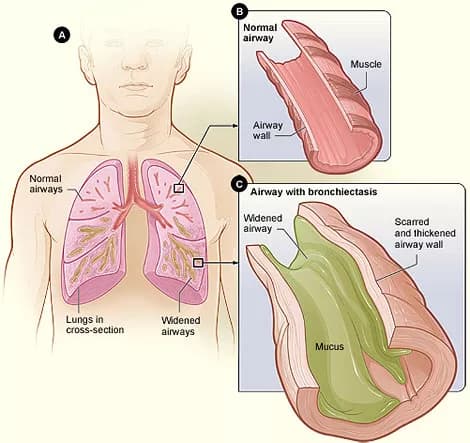
Bronchiectasis
What are the other Names for this Condition? (Also known as/Synonyms)
- Acquired Bronchiectasis
- Congenital Bronchiectasis
What is Bronchiectasis? (Definition/Background Information)
- Bronchiectasis is a condition in which the lung's airways are abnormally stretched, resulting in them becoming wider and flabby. The airways are tube-like structures responsible for carrying the air to the lungs
- The condition results from an infection or other diseases which harm the walls of the airways and do not allow the mucus to pass through
- The mucus is a slimy material which aids in removing dust, bacteria, and other particles that pass through the airway. In this condition, mucus builds up in the airways, causing bacteria to grow
- Common signs and symptoms associated with Bronchiectasis are coughing-up blood, chest pain, and shortness of breath
- With appropriate treatment of Bronchiectasis, most of the patients are able to live a normal life
Who gets Bronchiectasis? (Age and Sex Distribution)
- Bronchiectasis is lung damage that originates during childhood. Symptoms for the condition may not appear for several months or years after the individual is exposed to lung damage
- Bronchiectasis can present as a congenital or an acquired disease, meaning that one may be born with the condition or it may develop later in life
- Congenital Bronchiectasis affects the development of the lungs during fetal growth
- Acquired Bronchiectasis arises due to other conditions or factors; it can affect both children and adults
- The condition is observed worldwide; there is no racial or ethnic predilection
What are the Risk Factors for Bronchiectasis? (Predisposing Factors)
The risk factors for Bronchiectasis include:
- Chronic obstructive lung disease usually secondary to smoking
- Serious lung infection
- Foreign body aspiration
It is important to note that having a risk factor does not mean that one will get the condition. A risk factor increases ones chances of getting a condition compared to an individual without the risk factors. Some risk factors are more important than others.
Also, not having a risk factor does not mean that an individual will not get the condition. It is always important to discuss the effect of risk factors with your healthcare provider.
What are the Causes of Bronchiectasis? (Etiology)
- Bronchiectasis is caused by an injury to the airway walls. The injury can be due to infections such as severe pneumonia, pertussis, tuberculosis, or fungal infections
- More commonly in young children, inhalation of small items, such as toy pieces, peanut, popcorn, etc., can cause blocked airways
- Some cases of Bronchiectasis are also due to cystic fibrosis; when children are born with abnormally thickened mucus blocking the airways and digestive tube
- Individuals with alpha-1 antitrypsin deficiency may also develop Bronchiectasis
What are the Signs and Symptoms of Bronchiectasis?
Sign and symptoms associated with Bronchiectasis are:
- Bluish skin color
- Bad smell in the breath
- Chronic cough with sputum, the sputum may also contain blood
- Clubbing of fingers
- Fatigue
- Shortness of breath, wheezing
- Weight loss
How is Bronchiectasis Diagnosed?
- The diagnosis of Bronchiectasis may include a thorough physical exam along with an evaluation of one’s medical history
- Examination of chest is very important to listen for abnormal breathing
Diagnostic tests include:
- Chest x-ray
- Chest CT scan
- Sputum culture
- Lab test for alpha-1 antitrypsin levels in blood
Many clinical conditions may have similar signs and symptoms. Your healthcare provider may perform additional tests to rule out other clinical conditions to arrive at a definitive diagnosis.
What are the possible Complications of Bronchiectasis?
Complications associated with Bronchiectasis include:
- Cor pulmonale: Right-sided heart failure secondary to lung damage
- Coughing up blood
- Recurrent pneumonia
How is Bronchiectasis Treated?
The goal of Bronchiectasis treatment is to control mucus secretions that will help reduce the airway obstruction.
- The patient will be placed on antibiotics for infection
- Bronchodilators to open airways and expectorants to help cough up the mucus may be used
- Physical therapy techniques are performed to help clear the mucus along with oxygen therapy
- Lung transplantation can also be considered in patients with severely damaged lungs
How can Bronchiectasis be Prevented?
- The risk can be reduced if the lung infections are diagnosed early and appropriately treated
- Individuals who are at risk and all children should have an updated vaccination status
- Avoiding inhalation of toxic fumes, smoke, or other harmful substances to the lungs will also decrease the probability of getting the condition
What is the Prognosis of Bronchiectasis? (Outcomes/Resolutions)
- Overall, the prognosis of patients with bronchiectasis is good, though it also depends on the underlying and causative factors
- With appropriate treatment, a majority of the affected individuals do well and are able to lead a normal quality of life
- Bronchiectasis associated with cystic fibrosis has a worse prognosis
Additional and Relevant Useful Information for Bronchiectasis:
- Respiratory tract infections in children should always be paid proper attention and promptly treated
- Chronic obstructive pulmonary disease (COPD) causes severe damage to the lungs and affects airflow, mainly expiration
The following article link will help you understand Chronic Obstructive Pulmonary Disease:
http://www.dovemed.com/diseases-conditions/chronic-obstructive-pulmonary-disease-copd/
Related Articles
Test Your Knowledge
Asked by users
Related Centers
Related Specialties
Related Physicians
Related Procedures
Related Resources
Join DoveHubs
and connect with fellow professionals

0 Comments
Please log in to post a comment.